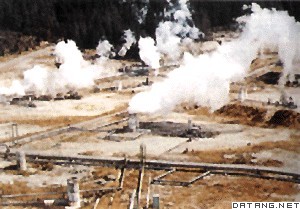1) geothermal energy resources


地热能资源<能>
2) ground energy source


地能资源
1.
Ground source heat pump(GSHP) system can provide heating and cooling with higher efficiency and cleaner environment,by means of the un exploitative utilization of shallow ground energy source(soil,groundwater,surfacewater,and surplus energy produced by industry and human living).
地下浅层地能资源 (包括土壤、地下水、地表水和人类的生产生活低位能量等 )的非开采利用 ,可以通过热泵装置实现供热和制冷的双重作用。
3) heat energy utilization


热能资源化
1.
Concepts and classification concerning municipal sewage heat energy utilization;


关于城市污水热能资源化相关概念和分类的探讨
4) function of groundwater resource


地下水资源功能
1.
According to the intrinsic relation between the function of groundwater resource and its sensitivity to pollution, this paper deals with the spatial relationship based on statistical analysis with Hufu plain as the study area.
本文以滹滏平原为研究区,从地下水资源功能和地下水易遭污染脆弱性内在联系为切入点,采用统计分析的方法,探讨地下水的资源功能与易遭污染脆弱性关系。
5) energy resources


能源资源
1.
The Study on Energy Resources Value Based on Sustainable Devlopment Theory;


基于可持续发展理论的能源资源价值研究
2.
In order to acquire the energy resources which is vital to prosperity and development of human society, it is necessary to study sedimentary basins more intensively.
当今人类社会正面临环境、资源与灾害问题的严峻挑战 ,要获得对人类社会繁荣发展至关重要的能源资源就需要更深入地研究盆地。
3.
This paper analyzes the severe situation of energy resources shortage and studies quantitatively the problems related to energy demands.
从近20多年来我国社会经济高速发展、能源需求长期高速增长、能源资源又相对很贫乏的现实情况出发,深入分析了我国将面临能源短缺的严峻形势;同时,还定量分析了能源需求所带来的各种生态环境和社会问题。
6) energy resource


能源资源
1.
Three aspects of gas hydrates are important:their energy resource potential for the 21st century, their role.
由于天然气水合物处于亚稳定状态,因此天然气水合物既可作为21世纪潜在的能源资源,又可以非稳定状态导致海底滑塌和滑坡等地质灾害,并可通过释放甲烷影响全球气候。
2.
The article mainly analyses and approaches the characters of our energy resource and the characters and the problems of developing and using energy resource, but also advances the main way to develop and use our energy resource rationally according to our national condition.
本文主要就我国能源资源特点,能源开发利用的特点及问题加以分析探讨,并针对我国国情提出能源合理开发利用的主要途径。
3.
This article comprehensively analyzed the development of energy resources in Guizhou,as well as the development and utilization of the coal and water energy resources.
本文通过对能源资源的综合分析评价,揭示了贵州省能源资源的基本特点和开发利用的有利条件,并分别探讨了煤炭和水能资源的开发利用问题。
补充资料:地热能
| 地热能 geothermal energy 离地球表面 5000 米深,15℃以上的岩石和液体的总含热量。据推算约为 14.5×1025焦耳(J) ,约相当于4948万亿吨( t )标准煤的热量。地热来源主要是地球内部长寿命放射性同位素热核反应产生的热能。按照其储存形式,地热资源可分为蒸汽型、热水型、地压型、干热岩型和熔岩型 5大类。世界地热资源主要分布于以下5个地热带: ①环太平洋地热带。世界最大的太平洋板块与美洲、欧亚、印度板块的碰撞边界,即从美国的阿拉斯加、加利福尼亚到墨西哥、智利,从新西兰、印度尼西亚、菲律宾到中国沿海和日本。世界许多地热田都位于这个地热带,如美国的盖瑟斯地热田,墨西哥的普列托、新西兰的怀腊开、中国台湾的马槽和日本的松川、大岳等地热田。 ②地中海、喜马拉雅地热带。欧亚板块与非洲、印度板块的碰撞边界,从意大利直至中国的滇藏。如意大利的拉德瑞罗地热田和中国西藏的羊八井及云南的腾冲地热田均属这个地热带。 ③大西洋中脊地热带。大西洋板块的开裂部位,包括冰岛和亚速尔群岛的一些地热田。 ④红海、亚丁湾、东非裂谷地热带。包括肯尼亚、乌干达、扎伊尔、埃塞俄比亚、吉布提等国的地热田。 ⑤其他地热区。除板块边界形成的地热带外,在板块内部靠近边界的部位,在一定的地质条件下也有高热流区,可以蕴藏一些中低温地热,如中亚、东欧地区的一些地热田和中国的胶东、辽东半岛及华北平原的地热田。
地热资源温度的划分。中国一般把高于 150℃的称为高温地热,主要用于发电。低于此温度的叫中低温地热,通常直接用于采暖、工农业加温、水产养殖及医疗和洗浴等。截止1990年底,世界地热资源开发利用于发电的总装机容量为588万千瓦,地热水的中低温直接利用约相当于1137万千瓦。 |
说明:补充资料仅用于学习参考,请勿用于其它任何用途。
参考词条
